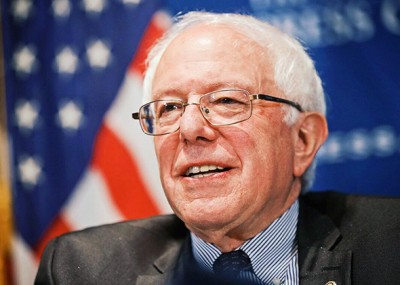The Candidate Rides Again: The Bernie Sanders Re-Run

He could not stay away, and few could blame him. Such political tendencies are nerves, conditions, diseases: eventually, we have to succumb to them. Bernie Sanders has announced his intention to run for the White House in 2020. It was as surprising as any statement about US inequality. But what matters here is the crowd – and a large one at that – that Sanders has to contend with this time around.
The primary problem here is timing and that old nag of history. Politics has, at its core, a clock. Ticking, with an ancient menace, it reminds politicians that a time to challenge comes only once in a time, if not a life time. It might resurface, supplying the failed candidate with a chance for redemption. Generally, this is rare; politics and Lazarus do not tend to meet.
The short of it is this: Abiding by the tick-tock of political opportunity benefits the shrewd and calculating. On evidence, Sanders is neither shrewd nor calculating. Passionate, yes. Buckets of character, yes. On some level, conditionally principled, but otherwise green on the kill. His capitulation to Hillary Clinton and her family’s strangling apparatus over the Democratic Party was significant in giving the brightest of green lights to Trump.
The populist election should have been a battle of the populists, and for some time, Sanders’ 2016 campaign was marked by colours different from the standard Democratic line. His movement into the Democratic universe proved to be a mistake, though it should never be forgotten that he has, at stages of his political life, hugged the outlines of that confused “centrist” party.
His voting record show patches of poor, and, in some instances severely compromised judgment. He favoured sending his state’s nuclear waste to the township of Sierra Blanca, Texas in 1998 (better out of Vermont than in). He favoured the sanctions regime against Iraq, one that did much to cause desperation in the populace and nothing to dislodge Saddam Hussein’s regime. And, in a fit of humanitarianism-at-the-end-of-a-missile, he supported the attack on Serbia in 1999. This was all the more galling given Sanders’ credentials as the great anti-war activist.
The point was not missed by fifteen Vermonters who proceeded to occupy his office. As Jeffrey St. Clair and Alexander Cockburn remind us,
“The last time any political rep from Vermont had an office occupied was when a group later known as the Winooski 44 sat in (Republican) Jim Jeffords’s office in 1984, protesting Reagan’s war in Central America.”
The befuddled statisticians, strategists and Mook-governed sociopaths in the Clinton camp attempted to absorb the threat posed by the Sandernistas, thereby extinguishing it while hoping to grab the voter base. This did not happen, and a campaign was strangled.
Not all blame can be laid at Clinton’s feet and venal calculation. Sanders retreated, effectively abandoning his supporters. That old hard-nosed Russian dissident Boris Kagarlisky had something to merit the following remark: in Philadelphia, as he surrendered to Clinton, the political figure from Vermont became “a pathetic old man who does not understand what is happening around him.”
Sanders may well have aroused the electorate, but he had no desire to consummate his attraction. Instead he spoke about the future.
“Together, we continue to fight to create a government that represents all of us, and not just the one percent – a government based on the principles of economic, social, racial and environmental justice.”
Now, Sanders does not come out as the fresh eccentric and dynamic alternative figure. He is an establishment candidate whose message of “Medicare for all” and a Green New Deal has been, for the most part, accepted by the bevy of Democrats making the White House charge. While it would be nonsense to suggest that the United States has suddenly become more attuned to social democratic principles, there is something to suggest greater receptiveness to them.
Sanders himself acknowledges how his flush of ideas was received in 2016.
“Three years ago, during our 2016 campaign, when we brought forth our progressive agenda we were told that our ideas were ‘radical’, and ‘extreme’. We were told that Medicare for All, a $15 an hour minimum wage, free tuition at public colleges and universities, aggressively combating climate change, demanding that the wealthy start paying their fair share of taxes, were all concepts that the American people would never accept.”
After three years “millions of Americans” were now “standing up and fighting back”, in the process supporting “all of these policies”.
Sanders, this time around, is playing on the unity message. As an announcement of his candidacy goes,
“I’m running for president because, now for than ever, we need leadership that brings us together not divides us up. Women and men, black, white, Latino, Native American, Asian American, gay and straight, young and old, native born and immigrant. Now is the time for us to stand together.”
Against the whole gaggle of female candidates, and a spread of younger variants of himself who have made it clear that they want the laurels; and against other aged hopefuls, Sanders has a mountain to climb so high he may lose his breath. But US politics, since 2016, is as interesting as any other theatre on the planet. Best call off the bets and wait the next turn.
*
Note to readers: please click the share buttons below. Forward this article to your email lists. Crosspost on your blog site, internet forums. etc.
Dr. Binoy Kampmark was a Commonwealth Scholar at Selwyn College, Cambridge. He lectures at RMIT University, Melbourne. He is a frequent contributor to Global Research and Asia-Pacific Research. Email: [email protected]

